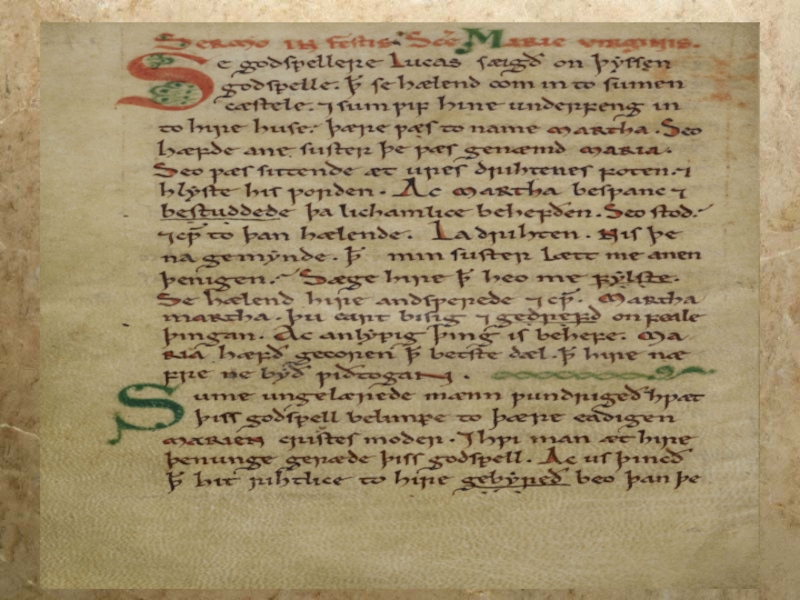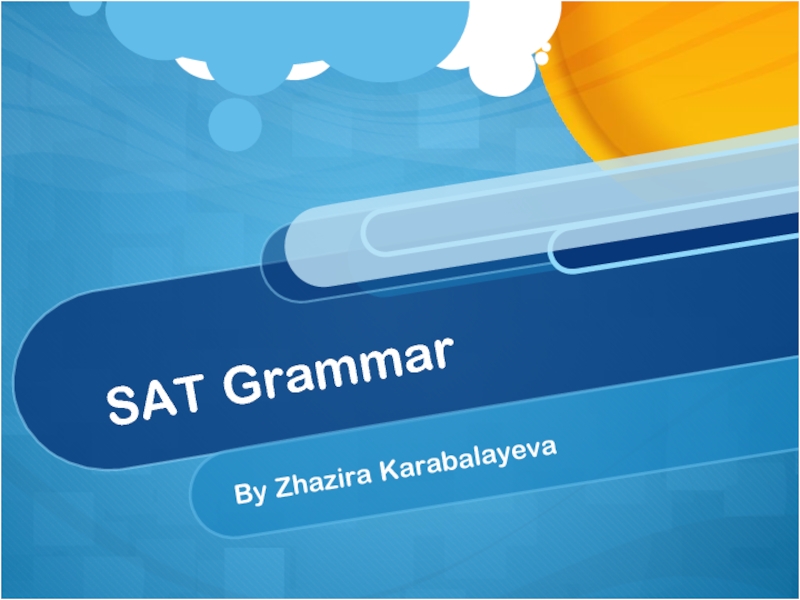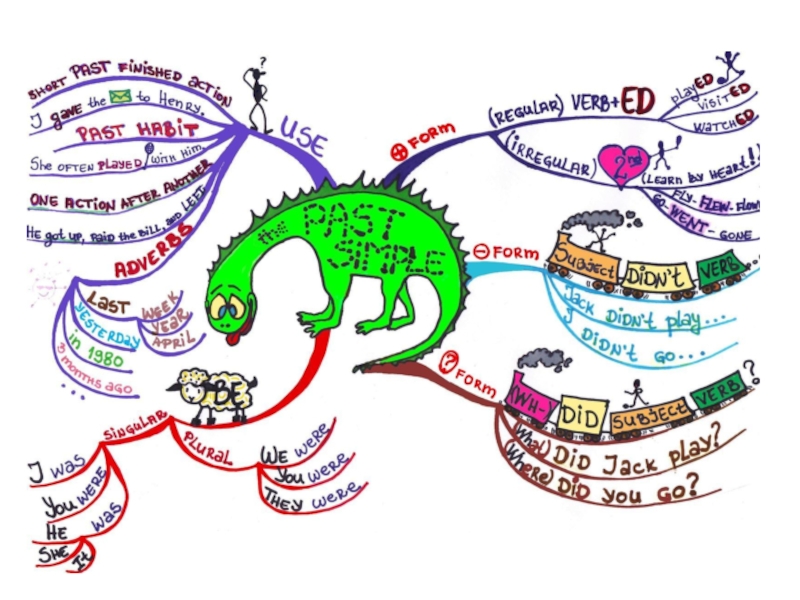- Главная
- Разное
- Дизайн
- Бизнес и предпринимательство
- Аналитика
- Образование
- Развлечения
- Красота и здоровье
- Финансы
- Государство
- Путешествия
- Спорт
- Недвижимость
- Армия
- Графика
- Культурология
- Еда и кулинария
- Лингвистика
- Английский язык
- Астрономия
- Алгебра
- Биология
- География
- Детские презентации
- Информатика
- История
- Литература
- Маркетинг
- Математика
- Медицина
- Менеджмент
- Музыка
- МХК
- Немецкий язык
- ОБЖ
- Обществознание
- Окружающий мир
- Педагогика
- Русский язык
- Технология
- Физика
- Философия
- Химия
- Шаблоны, картинки для презентаций
- Экология
- Экономика
- Юриспруденция
The middle english period презентация
Содержание
- 1. The middle english period
- 2. Plan Main historical events of ME. ME dialects. Rise of the London dialect. Orthographical changes.
- 3. Literature Расторгуева Т.А. История английского языка. –
- 4. Middle English The period
- 5. Main historical events of the ME
- 6. In 1016 the Danish king Cnut (Canute)
- 7. The influence of Scandinavian dialects was especially
- 8. Greenwich In the areas where the Scandinavians
- 9. Norman Conquest Soon after Canute’s
- 10. In 1066, after Edward’s death,
- 11. In the battle of Hastings
- 12. The Normans became masters of
- 13. Norman property in England and France 1204 Loss of Normandy
- 14. English in the 13th century After loss
- 15. The growing importance of English Upper classes
- 16. French loan words Government and administration
- 17. French loan words Church and
- 18. French loan words Law
- 19. Army and navy army navy pace
- 20. Fashion dress habit fashion robe
- 21. Meals and food dinner supper
- 22. Furniture, social life couch chair
- 23. Art, learning, medicine art painting
- 24. Loss of Germanic words French borrowing
- 25. Middle English dialects Northern: had developed from
- 26. In the present state of our knowledge
- 27. The Rise of the London Dialect Growth
- 28. Reasons for Rise of the London
- 29. Reasons for Rise of the London
- 30. Orthographical changes of ME In ME the
- 32. Long sounds were shown by double letters ME wīd, wide, wiid [wi:d]
- 33. Some replacements were made to avoid confusion
- 35. THANK YOU FOR YOUR ATTENTION!
Слайд 2Plan
Main historical events of ME.
ME dialects.
Rise of the London dialect.
Orthographical changes.
Слайд 3Literature
Расторгуева Т.А. История английского языка. – М.: Астрель, 2005. – С.
Ильиш Б.А. История английского языка. – Л.: Просвещение, 1972. – С. 134-146.
Иванова И.П., Чахоян Л.П. История английского языка. – М.: Высшая школа, 1976. – С. 17-33.
Студенець Г.І. Історія англійської мови в таблицях. - К.: КДЛУ, 1998. – Tables 61-74.
Слайд 4Middle English
The period we call Middle English runs
Слайд 5Main historical events
of the ME period
By the end of the
The territory was recognized as Danish territory Danelaw (Danelaʒ - Danish law)
In the early years of occupation the Danish settlements were little armed camps.
Слайд 6In 1016 the Danish king Cnut (Canute) became ruler of England.
In the late 10th c. war was resumed and in 1013 the whole country fell to the invaders.
King Æthelred escaped to Normandy.
Слайд 7The influence of Scandinavian dialects was especially felt in the North
The relative ease of the mutual penetration of the languages was caused by the following circumstances:
no political / social barriers;
no cultural barriers;
both languages were similar.
The Scandinavian invasion and settlement,
the constant contacts and intermixture of the English and the Scandinavians brought about many changes in different spheres of the English language: word-stock, grammar and phonetics.
Слайд 8Greenwich
In the areas where the Scandinavians outnumbered the Anglo-Saxon population, the
Слайд 9Norman Conquest
Soon after Canute’s death (1042) and the collapse
The new English king, Edward the Confessor brought to England many Norman advisors and favourites.
Слайд 10 In 1066, after Edward’s death, Harold God was proclaimed
Слайд 11 In the battle of Hastings (1066) Harold was killed
The date is known as the date of the Norman conquest
Слайд 12 The Normans became masters of England. William replaced the
William made the bishops at Westminster Abbey crown him king.
1204 Loss of Normandy
Слайд 14English in the 13th century
After loss of Normandy:
French remains
the dominant
At the end of the 13th century, English is used more commonly by
the upper classes.
King Henry III
1216-1272
Слайд 15The growing importance of English
Upper classes need to communicate with their
After the loss of the Normandy, French was no longer needed.
Speaking French was fashionable in the 13th century, but Norman French had much lower prestige than the French spoken in Paris.
Слайд 16French loan words
Government and administration
government crown
empire realm authority
court parliament assembly
traitor treason exile
liberty office mayor
prince baron duke
sir madam mistress
Слайд 17French loan words
Church and religion
religion sermon
prayer lesson passion
chant sacrifice chapter
abbey cloister virgin
saint miracle mystery
faith mercy pity
virtue preach pray
Слайд 18French loan words
Law
justice equity judgment
crime judge attorney
bill
evidence proof bail
ransom verdict sentence
award fine punishment
prison accuse indict
blame arrest seize
pledge condemn convict
acquit fraud perjury
property estate heir
entail just innocent
Слайд 19Army and navy
army navy pace
enemy battle combat
siege defense ambush
retreat soldier guard
spy
Слайд 20Fashion
dress habit fashion
robe coat collar
veil
embellish blue brown
fur jewel ivory
Слайд 21Meals and food
dinner supper boil
taste appetite salmon
beef
sausage bacon gravy
cream sugar salad
fruits orange roast
lemon cherry peach
spice mustard vinegar
Слайд 22Furniture, social life
couch chair screen
lamp blanket wardrobe
recreation leisure
fool music chess
stable retrieve falcon
forest park tournament
Слайд 23Art, learning, medicine
art painting beauty
color figure image
tone
tower porch bay
column vase poet
rime story paper
pen study logic
geometry grammar noun
clause copy medicine
stomach ointment poison
Слайд 24Loss of Germanic words
French borrowing
poor earm
people leod
guilty scyldig
army here
warrior cempa
air lyft
confess andettan
praise hearian
Слайд 25Middle English dialects
Northern: had developed from the Northumbrian dialect of OE.
West
East Midland: had developed from East Anglian, Essex.
Southern: a descendant of the OE Saxon dialect (West Saxon and East Saxon).
Kentish: a direct continuation of any of the OE dialects, and Kentish covers nearly the same geographical locations.
Слайд 26In the present state of our knowledge
In Early ME French was the state language, the main language of literature and local dialects were relatively equal.
In Late ME, when English had been reestablished as the main language of administration, one of the regional dialects prevailed over the others.
Слайд 27The Rise of the London Dialect
Growth of commerce and industry, development
New social relations created the need for a unified national language, standing above dialects equally intelligible in all parts of the country.
Слайд 28Reasons for Rise
of the London Dialect
Midland dialects: middle position between
East Midlands: the largest, most populous area – fertile, prosperous, agricultural area with larger wealthier population.
Influence of Oxford and Cambridge, rapidly developing, role of monasteries decreasing.
Role of Chaucer, popular in his days and in the 15th c.
Role of London as capital city, political and commercial center of England, seat of royal court, law court, social, intellectual activity, much movement of people in and out of the city – local dialects mixed together to form a combination – the London standard (what began as a southern dialect, ended up as East Midland)
Слайд 29Reasons for Rise
of the London Dialect
Chancery (government, writing office) standard.
The Chancery built a foundation of written English
that was developed by Caxton,
when he set up his printing press
in Westminster in 1476.
Слайд 30Orthographical changes of ME
In ME the runic letters passed out of
thorn (Ð) and crossed d (đ, ð) were replaced by the digraph th, which represented the same sounds [θ - ð].
The “wynn” was replaced by . “double u” (w) to prevent . confusion with “p”.
The ligatures (æ, œ) passed out of use.
During several centuries after the Norman conquest the business of writing was in the hands of French scribes. They introduced into English some peculiarities of French graphic habits.
Слайд 33Some replacements were made to avoid confusion was used not
To determine the sound value of
[i] -
[ai] -
[u:] -

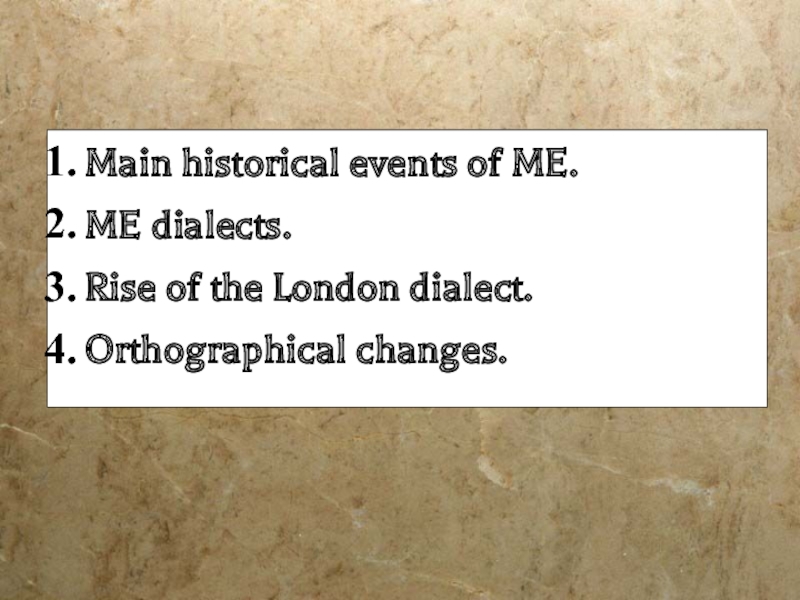
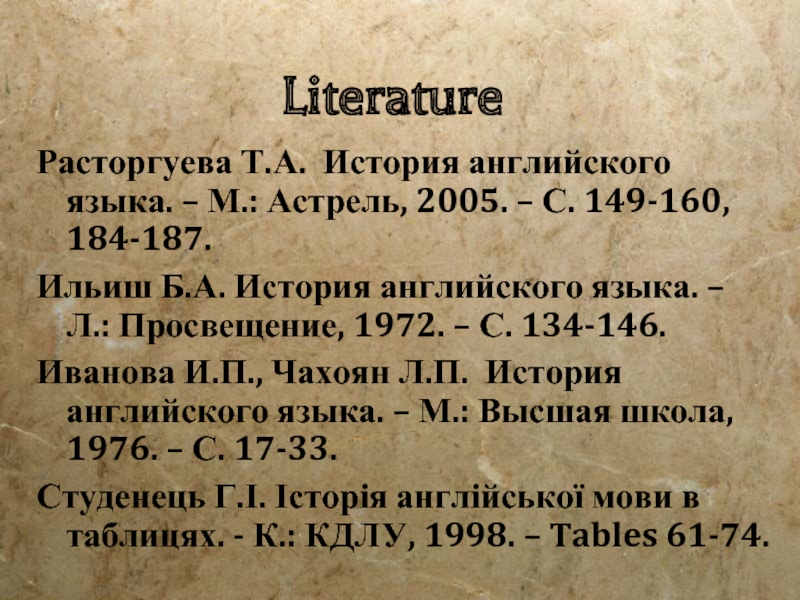

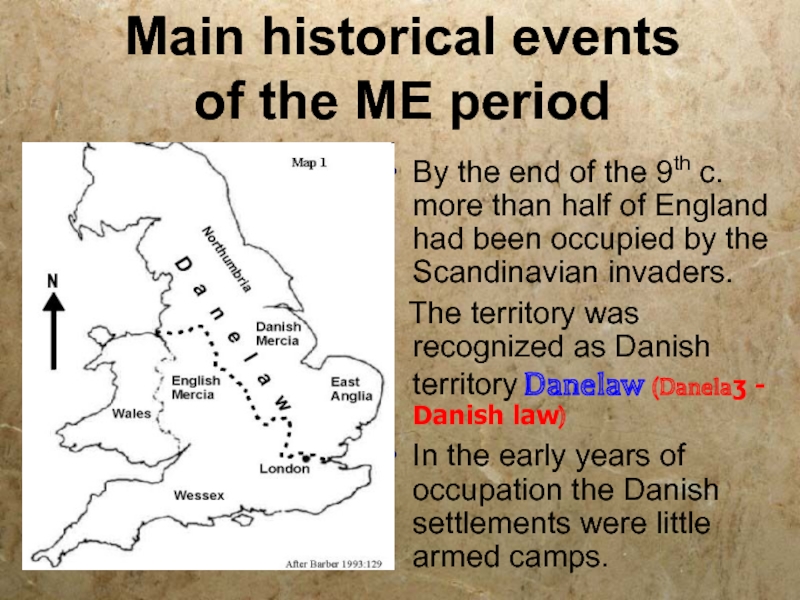
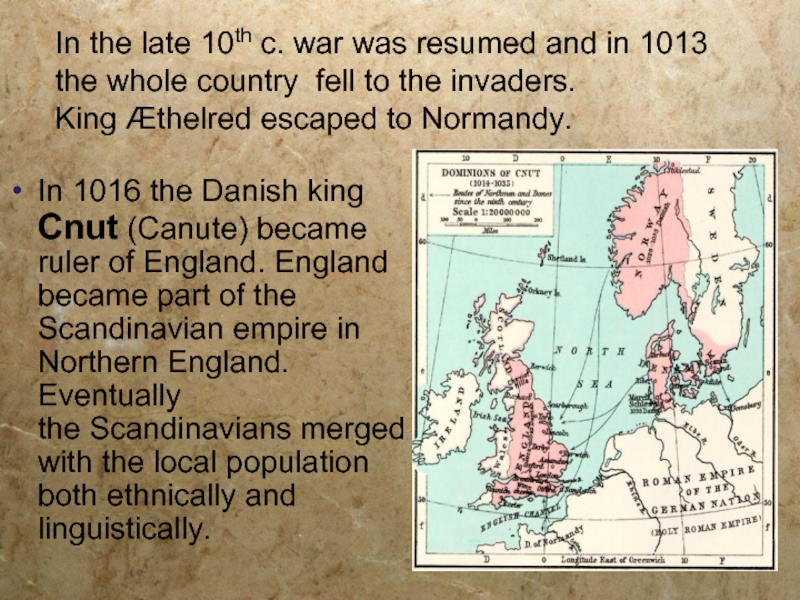
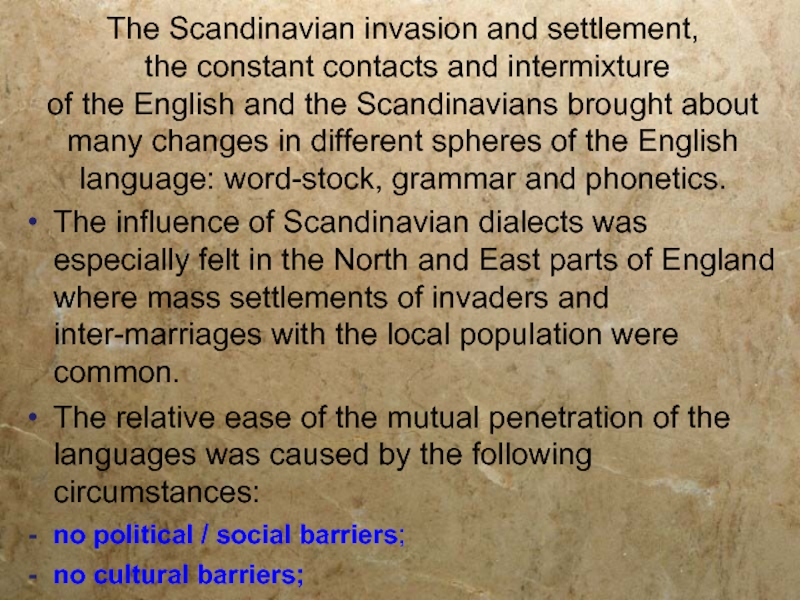
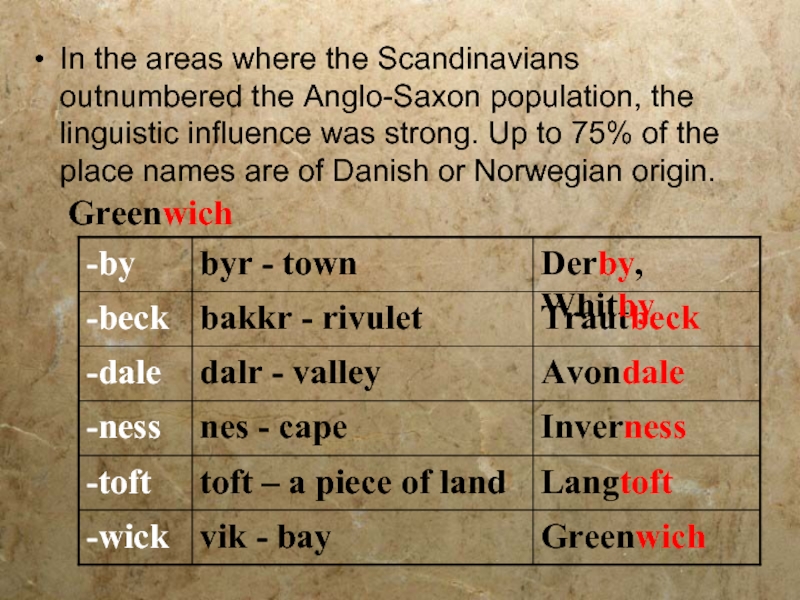
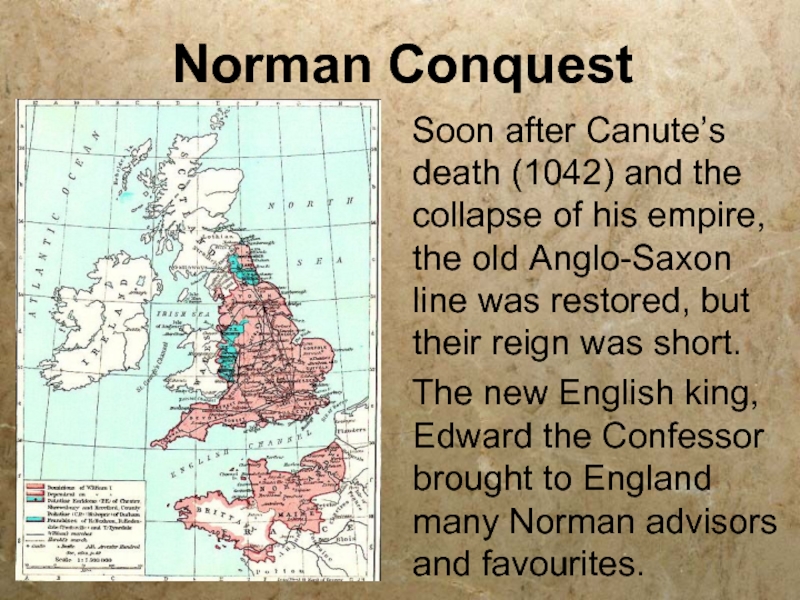
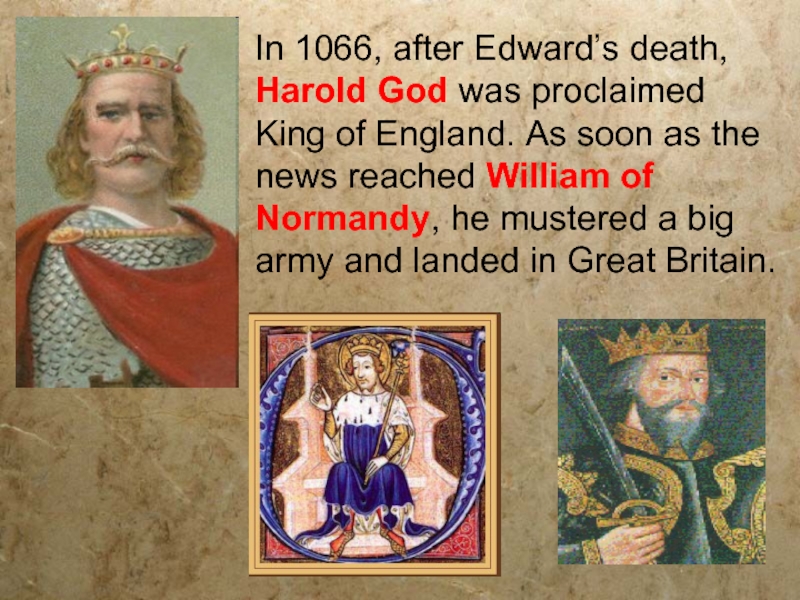
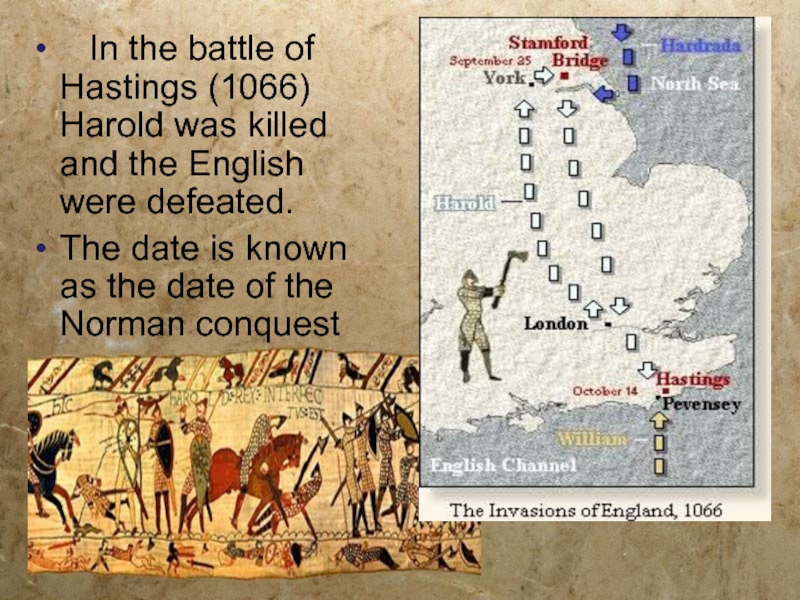
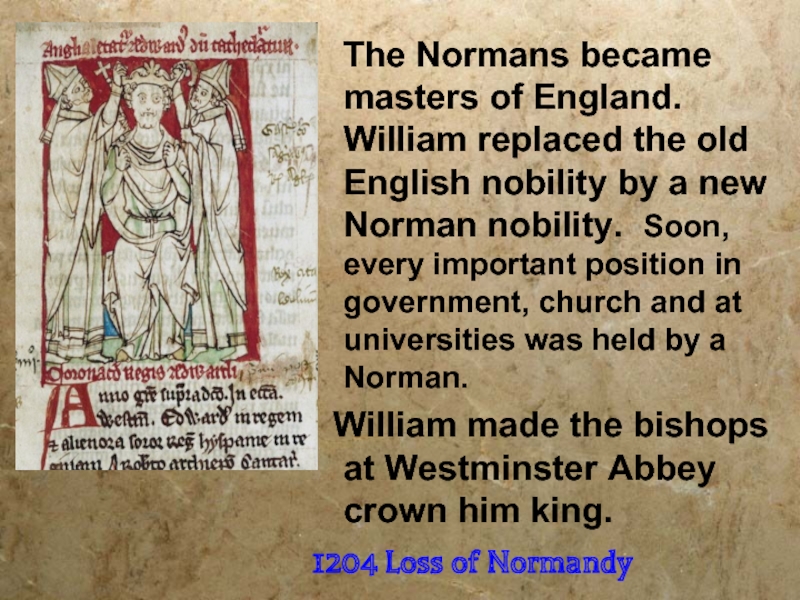
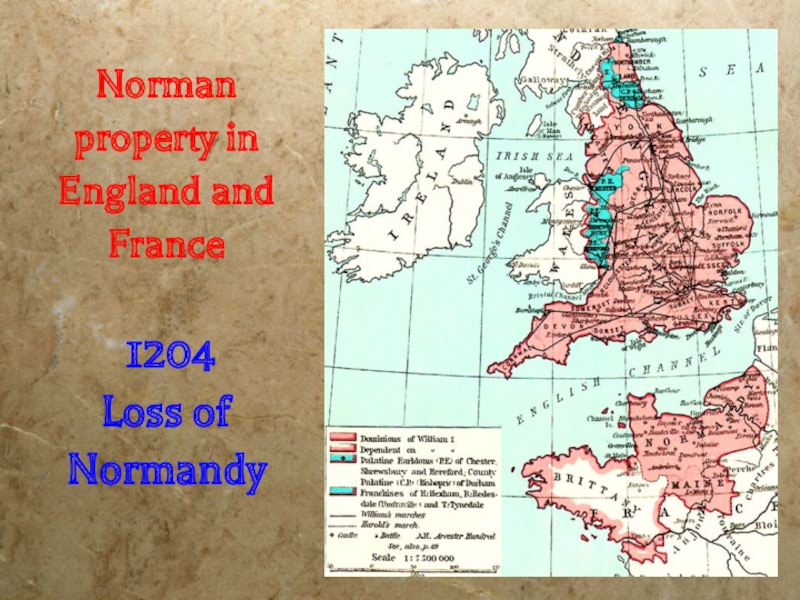
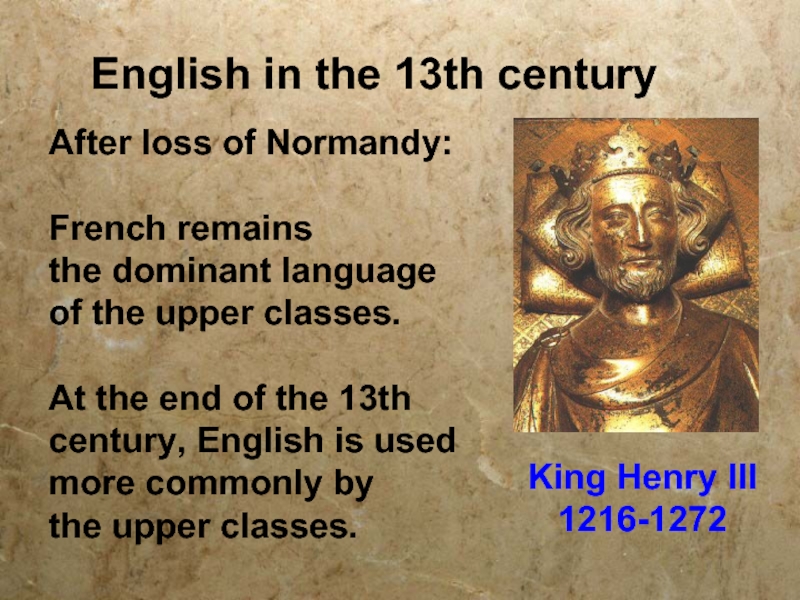
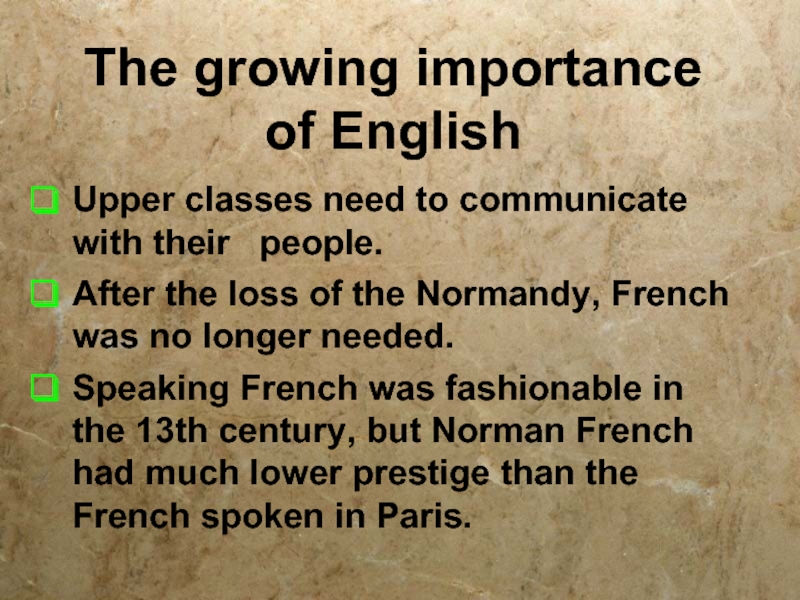
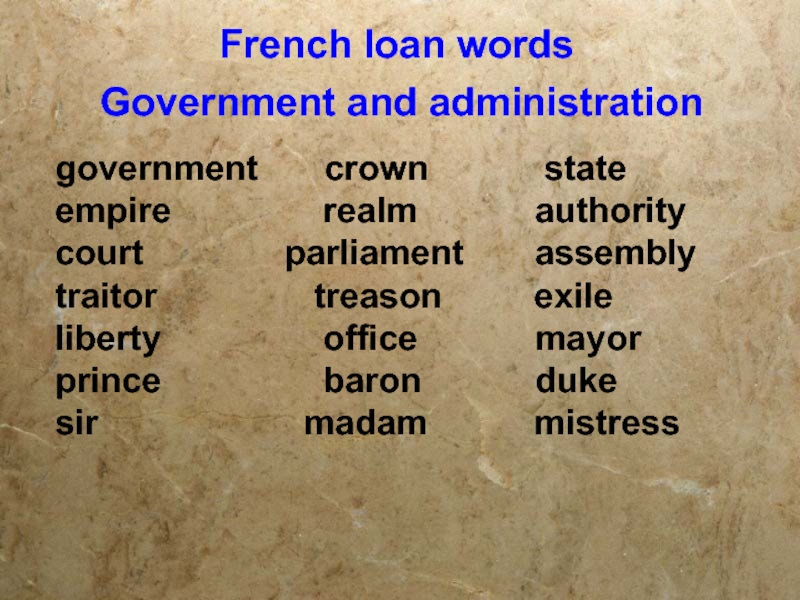

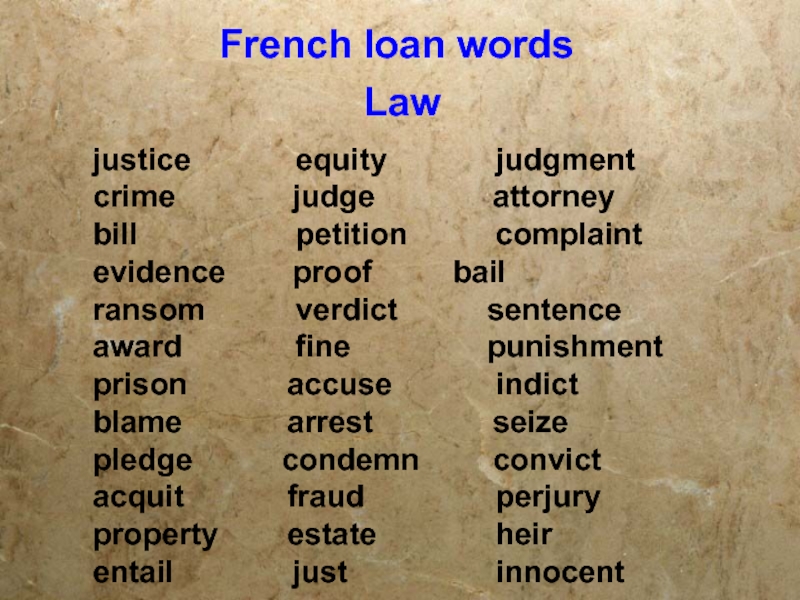




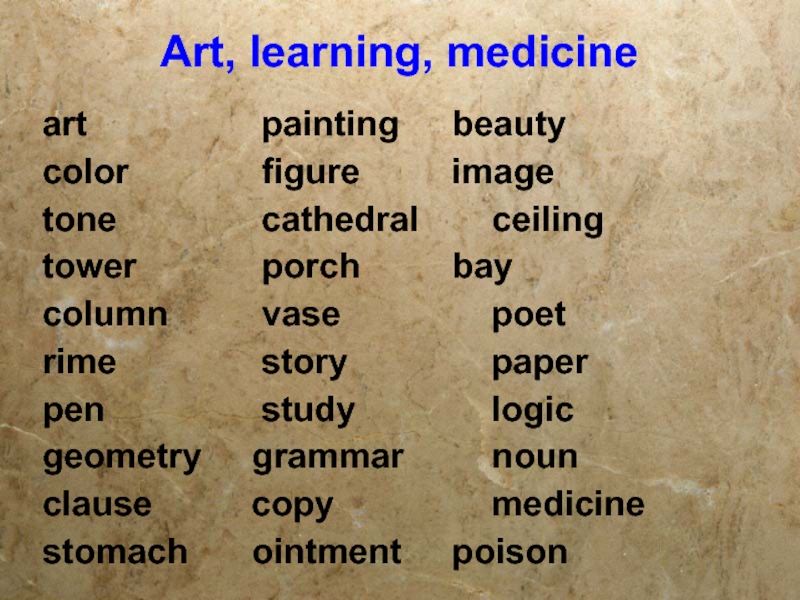
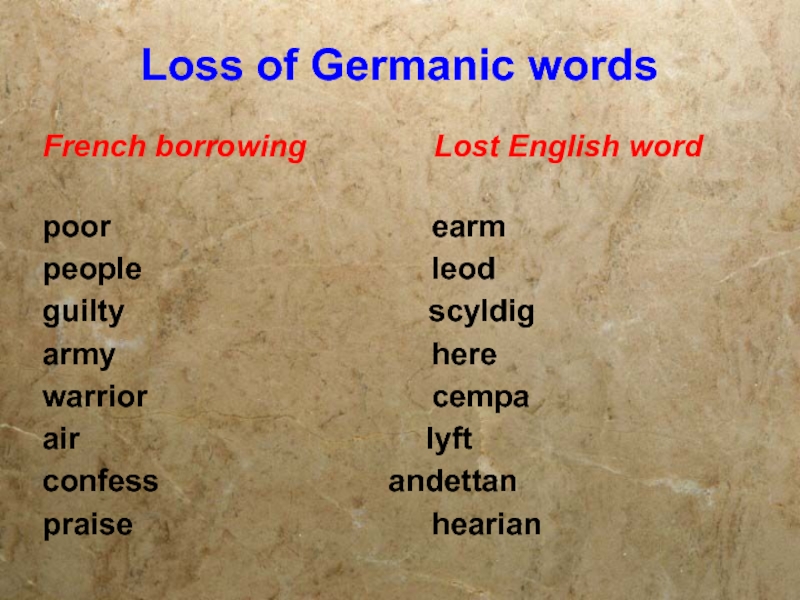
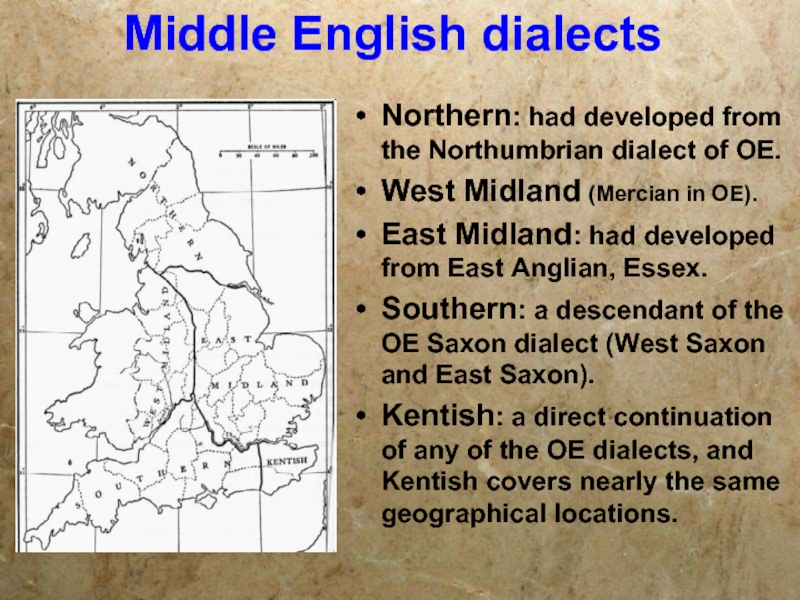
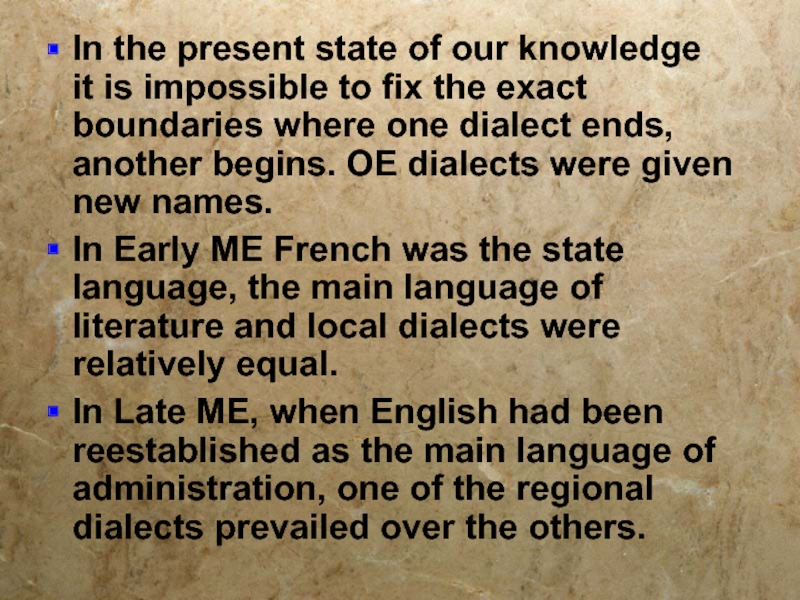
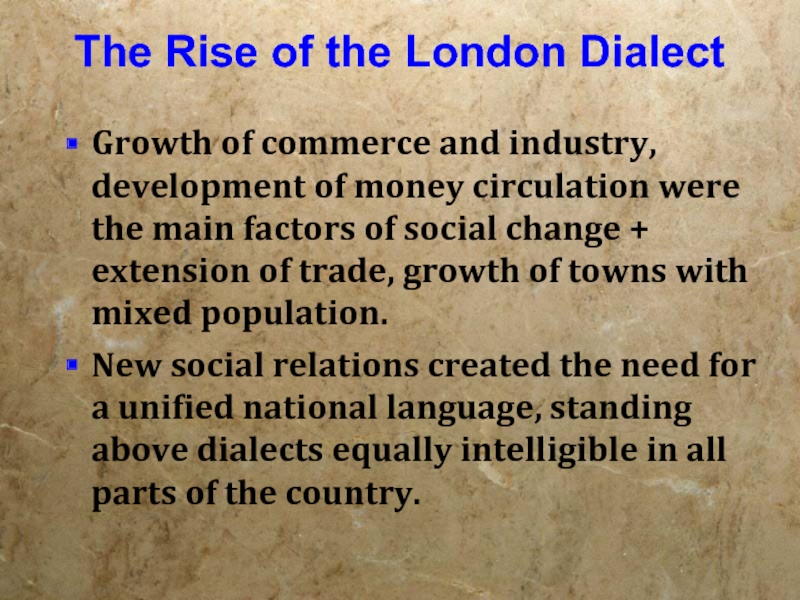
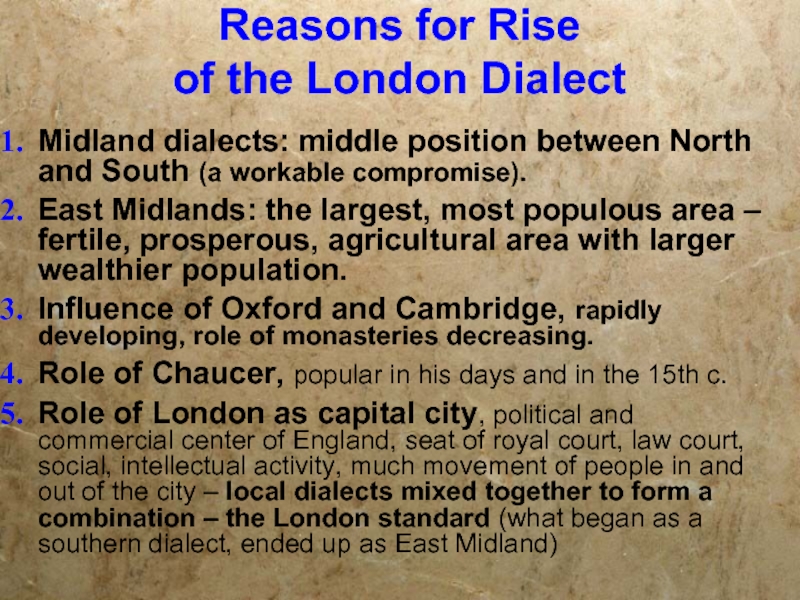
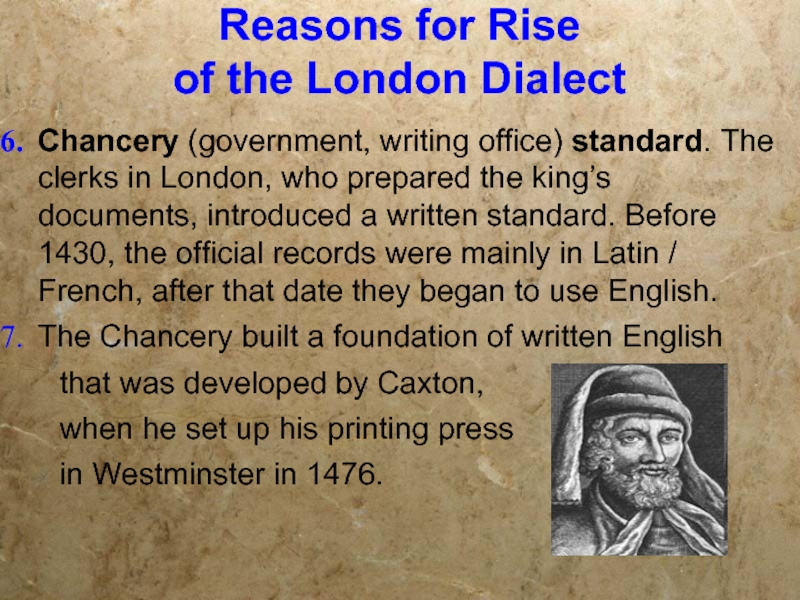
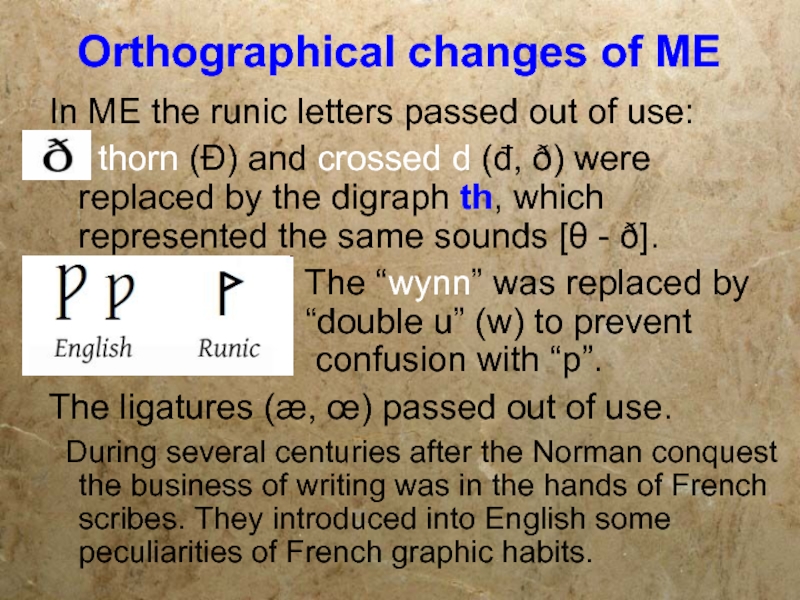
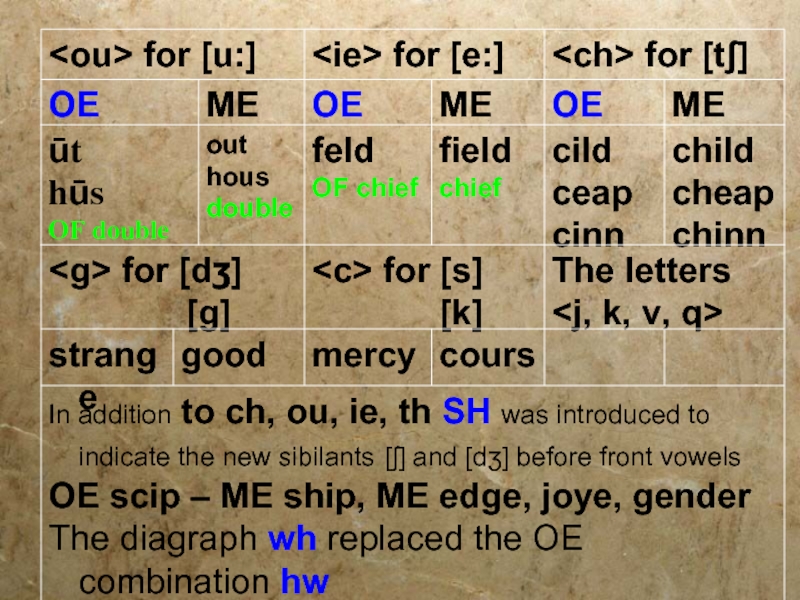
![Long sounds were shown by double letters ME wīd, wide, wiid [wi:d]](/img/tmb/1/11136/6c40e6fe828d8f45ca7b628117407e33-800x.jpg)
![Some replacements were made to avoid confusion was used not only to indicate [o], but](/img/tmb/1/11136/ab1d18245f9c6f30d63e7c5ce9f9e2d4-800x.jpg)
